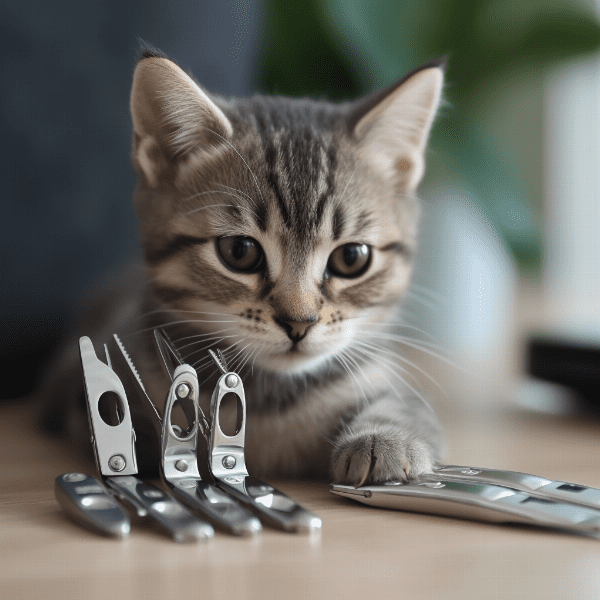Table of Contents
- Introduction: Understanding the Importance of Trimming Cats Claws
- How to Prepare for Claw Trimming: Gathering the Right Tools and Materials
- Step-by-Step Guide to Trimming Cats Claws: Techniques and Tips
- Common Mistakes to Avoid When Trimming Cats Claws
- Dealing with Resistant Cats: Handling Techniques and Alternative Solutions
- When to Trim Cats Claws: Frequency and Timing
- Benefits of Trimming Cats Claws: Health and Behavioral Advantages
- Alternative Methods to Manage Cat Claws: Scratching Posts and Caps
- Troubleshooting Claw Trimming: Dealing with Accidents and Injuries
- Conclusion: Maintaining Healthy Claws and Strengthening Bond with Your Cat.
Introduction: Understanding the Importance of Trimming Cats Claws
As a cat owner, you know that cats are naturally curious and love to explore their surroundings. They use their claws to climb, scratch, and play, which is essential for their physical and mental well-being. However, when cats’ claws become too long, it can lead to a range of problems, including torn furniture, damaged carpets, and even injuries to your cat.
The Consequences of Long Claws
Cats with long claws can accidentally scratch and injure themselves while playing or grooming. Additionally, long claws can easily get caught in carpets or furniture, causing them to become stuck and potentially leading to torn claws or injuries. In some cases, cats with overgrown claws may even develop infections if dirt and bacteria become trapped under their nails.
The Importance of Regular Trimming
Regular claw trimming is essential to prevent these issues and maintain your cat’s health and well-being. By trimming your cat’s claws, you can prevent them from becoming too long, reducing the risk of injuries and infections. Regular trimming can also help to minimize damage to your furniture and carpets, saving you money on repairs and replacements in the long run.
The Benefits of Trimming Cats Claws
Trimming your cat’s claws has several benefits beyond preventing injuries and damage. Shorter claws are less likely to get stuck in carpets or furniture, reducing your cat’s chances of getting injured. Regular trimming can also help to keep your cat’s nails strong and healthy, preventing them from becoming brittle or splitting. Additionally, trimming your cat’s claws can reduce their need to scratch, which can help to minimize damage to your furniture and carpets.
In summary, trimming your cat’s claws is an essential part of cat care that can prevent injuries, damage to your home, and infections. In the next section, we’ll discuss how to prepare for claw trimming and gather the right tools and materials.

How to Prepare for Claw Trimming: Gathering the Right Tools and Materials
Before you start trimming your cat’s claws, it’s important to gather the right tools and materials to ensure a safe and successful trimming session. Here are some essential items that you’ll need:
Claw Trimmers
Claw trimmers are the most important tool for trimming your cat’s claws. There are several types of claw trimmers available, including guillotine-style trimmers, scissor-style trimmers, and plier-style trimmers. Each type has its own advantages and disadvantages, so it’s important to choose the one that you feel most comfortable using.
Styptic Powder or Gel
Styptic powder or gel is a crucial item to have on hand in case you accidentally cut your cat’s quick while trimming their claws. The quick is the part of the nail that contains blood vessels and nerves, and cutting it can be painful for your cat and cause bleeding. Styptic powder or gel can help to stop the bleeding quickly and prevent infection.
Towels or a Blanket
Having a towel or blanket on hand can help to keep your cat calm and comfortable during the trimming session. You can use the towel to wrap your cat in a burrito-style hold, which can help to keep them still and prevent them from scratching or biting.
Treats and Positive Reinforcement
Using treats and positive reinforcement can help to make the trimming session more enjoyable for your cat and reduce their anxiety. You can offer your cat a treat after each claw is trimmed, or give them praise and affection to reinforce good behavior.
Choosing a Quiet and Comfortable Location
It’s important to choose a quiet and comfortable location for the trimming session, such as a quiet room with plenty of natural light. This can help to reduce your cat’s stress levels and make the experience more pleasant for both you and your cat.
By gathering the right tools and materials and choosing a comfortable location, you can help to ensure a safe and successful claw trimming session. In the next section, we’ll discuss the step-by-step guide to trimming your cat’s claws and share some tips and techniques to make the process easier.
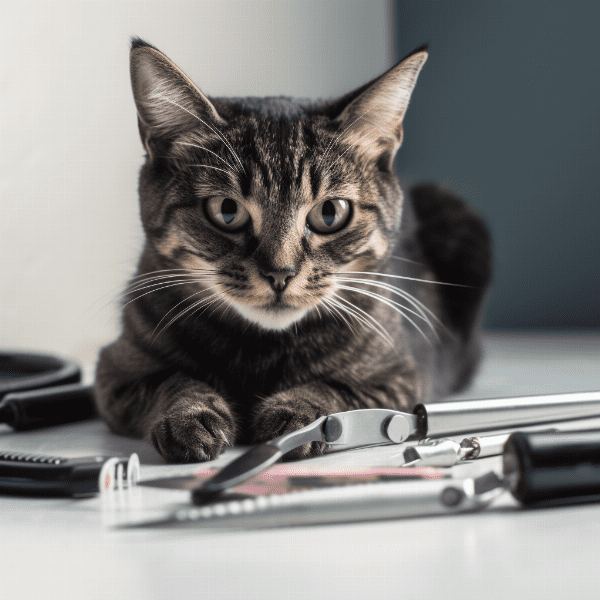
Step-by-Step Guide to Trimming Cats Claws: Techniques and Tips
Trimming your cat’s claws can seem daunting, but with the right technique and some practice, it can become a stress-free part of your cat care routine. Here’s a step-by-step guide to trimming your cat’s claws:
Step 1: Get Your Cat Comfortable
Before you start trimming, make sure your cat is comfortable and relaxed. You can wrap them in a towel or blanket to keep them still, or give them treats or positive reinforcement to make them feel at ease.
Step 2: Examine the Claw
Take a close look at your cat’s claws and identify the quick, which is the pinkish part of the nail that contains blood vessels and nerves. It’s important not to cut into the quick, as this can cause bleeding and pain for your cat.
Step 3: Position the Trimmer
Hold the trimmer with your dominant hand and position it perpendicular to the claw. For guillotine-style trimmers, insert the claw into the hole and close the blades. For scissor-style trimmers, position the blades so that they’re parallel to the claw.
Step 4: Make the Cut
Make a quick, decisive cut just below the quick. It’s better to cut too little than too much, as you can always trim more later. If you accidentally cut the quick, apply styptic powder or gel to stop the bleeding.
Step 5: Repeat
Repeat the process for each claw, taking breaks as needed to give your cat a rest or provide them with treats and positive reinforcement.
Tips for Easier Trimming
Here are some tips and techniques to make trimming your cat’s claws easier and more comfortable:
- Trim your cat’s claws after they’ve had a meal or a play session, as they’ll be more relaxed.
- Use a scratcher or toy to distract your cat during the trimming session.
- Trim your cat’s claws in a well-lit area so that you can see the quick clearly.
- If your cat is resistant, try trimming one or two claws per day until you’ve completed them all.
- Use treats and positive reinforcement to reward good behavior and make the trimming session more enjoyable.
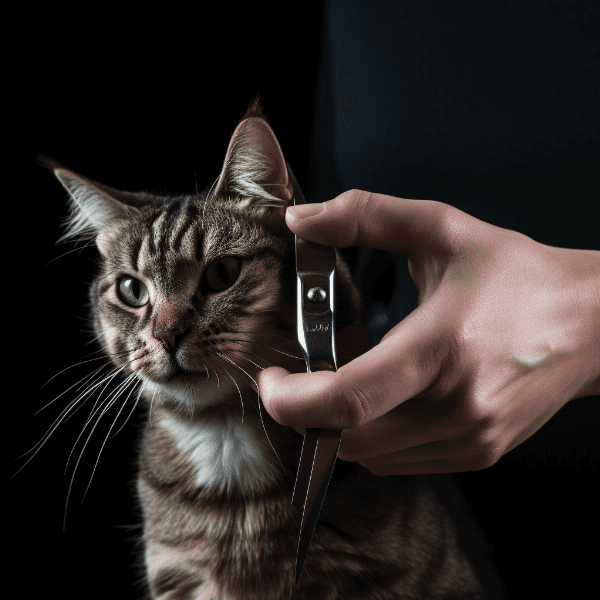
Common Mistakes to Avoid When Trimming Cats Claws
Trimming your cat’s claws can be tricky, and it’s important to avoid common mistakes that can cause pain or injury to your cat. Here are some mistakes to avoid when trimming your cat’s claws:
Mistake 1: Cutting the Quick
Cutting the quick can be painful for your cat and cause bleeding. It’s important to identify the quick and cut just below it to avoid injury. If you accidentally cut the quick, apply styptic powder or gel to stop the bleeding.
Mistake 2: Trimming Too Much
Trimming too much of your cat’s claw can cause pain and discomfort. It’s better to cut too little and trim more later than to cut too much. Take breaks as needed to give your cat a rest and make sure they’re comfortable.
Mistake 3: Using Dull or Incorrect Tools
Using dull or incorrect tools can make the trimming process more difficult and cause pain or injury to your cat. Make sure you have the right type of trimmer for your cat’s claws, and replace it if it becomes dull or damaged.
Mistake 4: Trimming Uncooperative Cats
Trimming uncooperative cats can be dangerous for both you and your cat. It’s important to take breaks as needed and provide your cat with treats and positive reinforcement to keep them calm and relaxed.
Mistake 5: Neglecting to Trim Regularly
Neglecting to trim your cat’s claws regularly can lead to overgrown claws, which can cause damage to your furniture and carpets and increase the risk of injury. Aim to trim your cat’s claws every two to four weeks to keep them healthy and strong.
By avoiding these common mistakes, you can trim your cat’s claws safely and easily, helping to maintain their health and well-being. In the next section, we’ll discuss how to deal with resistant cats and provide alternative solutions to make trimming easier.
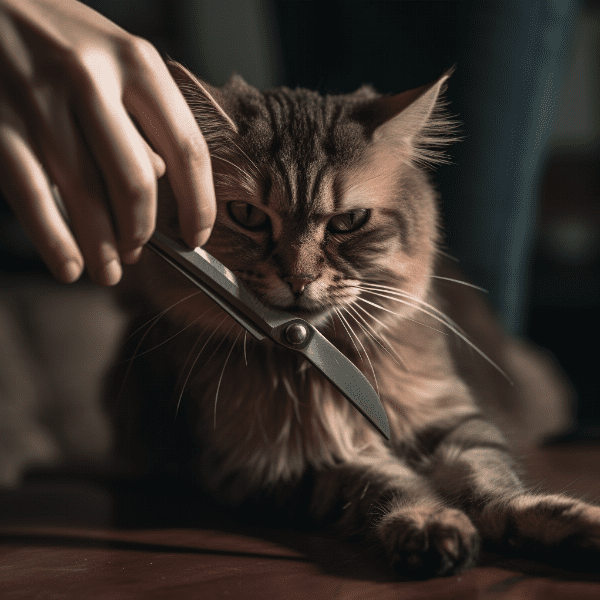
Dealing with Resistant Cats: Handling Techniques and Alternative Solutions
Some cats can be resistant to claw trimming, which can make the process more difficult and stressful for both you and your cat. Here are some handling techniques and alternative solutions to make the process easier:
- Wrap your cat in a towel or blanket to keep them still and prevent scratching or biting.
- Hold your cat firmly but gently, supporting their body and legs.
- Use a scratcher or toy to distract your cat during the trimming session.
- Take breaks as needed to give your cat a rest and provide them with treats and positive reinforcement.
Alternative Solutions
If your cat is extremely resistant to claw trimming, there are alternative solutions that you can try:
- Use claw caps: Claw caps are plastic caps that fit over your cat’s claws, preventing them from scratching and minimizing damage to your furniture and carpets. Claw caps can last up to six weeks and come in a variety of colors and sizes.
- Take your cat to a professional groomer: Professional groomers have experience in handling resistant cats and can trim your cat’s claws quickly and safely.
- Talk to your veterinarian: If your cat is extremely resistant to claw trimming, your veterinarian may be able to provide sedation or other solutions to make the process easier.
By using these handling techniques and alternative solutions, you can make claw trimming easier and more comfortable for both you and your cat. In the next section, we’ll discuss when to trim your cat’s claws and how often to do it.
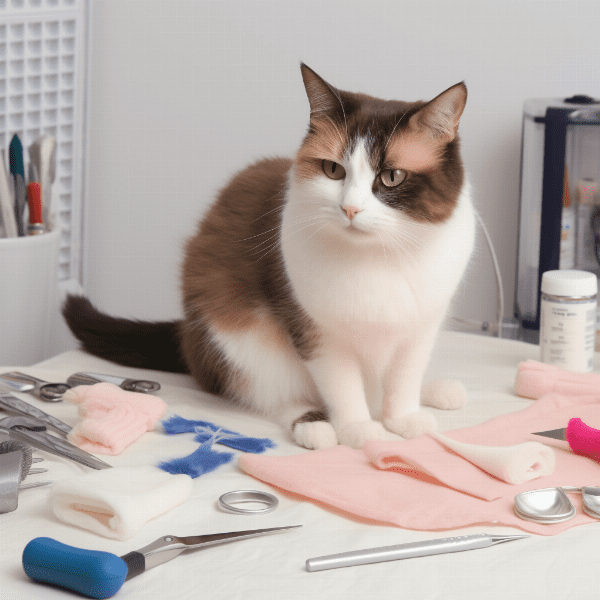
When to Trim Cats Claws: Frequency and Timing
Knowing when to trim your cat’s claws is essential to maintain their health and well-being. Here are some tips on when to trim your cat’s claws and how often to do it:
When to Trim Cats Claws
Trim your cat’s claws when you notice that they’re becoming too long or sharp. Signs that your cat’s claws need trimming include:
- Claw tips are visible when your cat is standing or walking.
- Your cat’s claws are catching on furniture or carpets.
- Your cat is scratching excessively.
How Often to Trim Cats Claws
How often you should trim your cat’s claws depends on several factors, including your cat’s age, activity level, and claw growth rate. As a general rule, aim to trim your cat’s claws every two to four weeks. However, if your cat is a senior or has limited mobility, they may need more frequent trimming. On the other hand, if your cat is young and active, they may need less frequent trimming.
Timing
The timing of claw trimming can also affect your cat’s comfort level. It’s best to trim your cat’s claws when they’re relaxed and calm, such as after a meal or a play session. Avoid trimming your cat’s claws when they’re agitated or stressed, as this can make the process more difficult and uncomfortable.
By knowing when to trim your cat’s claws and how often to do it, you can maintain your cat’s health and well-being and minimize damage to your furniture and carpets. In the next section, we’ll discuss the benefits of trimming your cat’s claws and how it can improve their health and behavior.

Benefits of Trimming Cats Claws: Health and Behavioral Advantages
Trimming your cat’s claws has several benefits beyond preventing injuries and damage to your home. Here are some health and behavioral advantages of regular claw trimming:
- Preventing overgrown claws that can lead to pain, discomfort, and injury.
- Reducing the risk of infections and other health issues caused by overgrown claws.
- Keeping your cat’s nails strong and healthy, preventing them from becoming brittle or splitting.
- Minimizing damage to your furniture and carpets, which can reduce stress and save you money on repairs and replacements.
- Reducing the need for your cat to scratch, which can prevent damage to your furniture and carpets and improve their behavior.
- Strengthening the bond between you and your cat by providing a positive, stress-free grooming experience.
Trimming your cat’s claws is an essential part of cat care that can prevent injuries, infections, and damage to your home. By regularly trimming your cat’s claws, you can maintain their health and well-being, reduce the risk of behavioral issues, and strengthen the bond between you and your furry friend. In the next section, we’ll discuss alternative methods to manage your cat’s claws, such as scratching posts and caps.

Alternative Methods to Manage Cat Claws: Scratching Posts and Caps
In addition to trimming your cat’s claws, there are alternative methods to manage your cat’s claws and prevent damage to your furniture and carpets. Here are two alternative methods to consider:
Scratching Posts
Scratching posts are essential for cats, as they provide a designated area for your cat to scratch and stretch their claws. When choosing a scratching post, look for one that’s sturdy and tall enough for your cat to fully stretch their body. You can also try different types of scratching surfaces, such as sisal rope or carpet, to see what your cat prefers. Encourage your cat to use the scratching post by placing it in a prominent location and rubbing it with catnip.
Claw Caps
Claw caps are plastic caps that fit over your cat’s claws, preventing them from scratching and minimizing damage to your furniture and carpets. Claw caps come in a variety of colors and sizes and can last up to six weeks. To apply claw caps, simply trim your cat’s claws and glue the caps onto each claw. It’s important to monitor your cat’s claws and replace the caps as needed.
By using scratching posts and claw caps, you can manage your cat’s claws and prevent damage to your home. However, it’s important to remember that these methods should not replace regular claw trimming, which is essential for your cat’s health and well-being. In the final section, we’ll summarize the key points of this guide and provide some concluding thoughts.
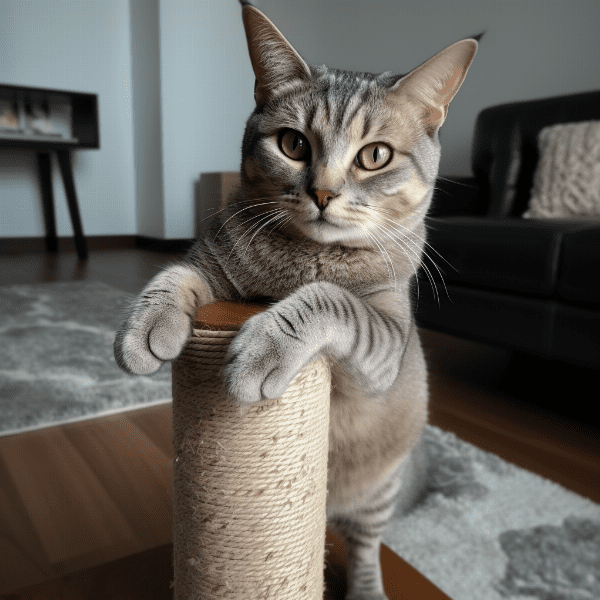
Troubleshooting Claw Trimming: Dealing with Accidents and Injuries
Accidents
If you accidentally cut the quick while trimming your cat’s claws, here’s what to do:
- Apply styptic powder or gel to the affected claw to stop the bleeding.
- Comfort your cat and give them treats or positive reinforcement to help them feel at ease.
- Monitor the affected claw for signs of infection or inflammation, such as redness or swelling.
Injuries
If your cat experiences an injury during claw trimming, such as a deep cut or puncture wound, here’s what to do:
- Apply pressure to the affected area with a clean cloth to stop the bleeding.
- Clean the wound with a gentle antiseptic solution.
- Monitor the affected area for signs of infection or inflammation, such as redness, swelling, or discharge.
- Take your cat to the veterinarian if the injury is severe or shows no signs of improvement.
Prevention
Prevention is the best way to avoid accidents and injuries during claw trimming. Here are some tips to prevent accidents and injuries:
- Use sharp, high-quality trimmers that are appropriate for your cat’s size and claw thickness.
- Avoid rushing or trimming too many claws at once, which can increase the risk of accidents.
- Keep a styptic powder or gel on hand in case of accidents.
By being prepared and taking precautions, you can minimize the risk of accidents and injuries during claw trimming. In conclusion, trimming your cat’s claws is an important part of cat care that can prevent injuries, infections, and damage to your home. With the right technique and some practice, you can trim your cat’s claws safely and easily, helping to maintain their health and well-being.
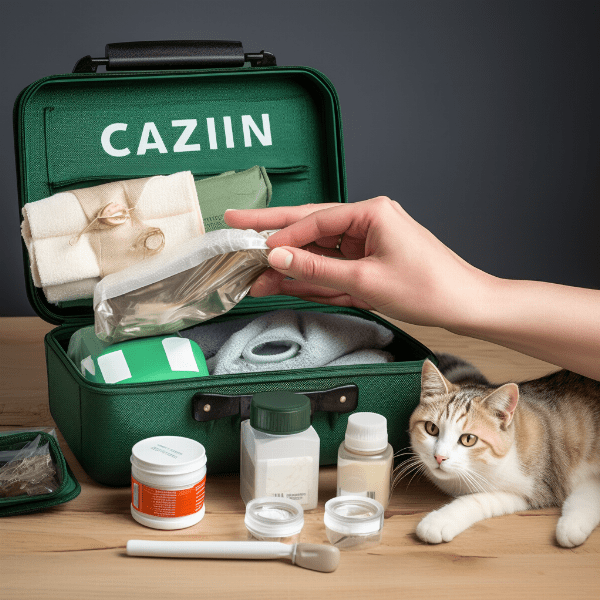
Conclusion: Maintaining Healthy Claws and Strengthening Bond with Your Cat.
In this guide, we’ve discussed the importance of trimming your cat’s claws and how to do it safely and effectively. By trimming your cat’s claws regularly, you can prevent injuries, infections, and damage to your home. We’ve also discussed alternative methods to manage your cat’s claws, such as scratching posts and claw caps, and how to deal with resistant cats.
Regular claw trimming also has behavioral and health advantages for your cat, such as reducing the need for scratching and strengthening the bond between you and your furry friend. In addition, we’ve provided troubleshooting tips for dealing with accidents and injuries that can occur during claw trimming.
Maintaining your cat’s claws is an essential part of cat care that can improve their health and well-being, and strengthen the bond between you and your cat. By following the tips and techniques in this guide, you can trim your cat’s claws safely and easily, providing a positive grooming experience for both you and your furry friend.


